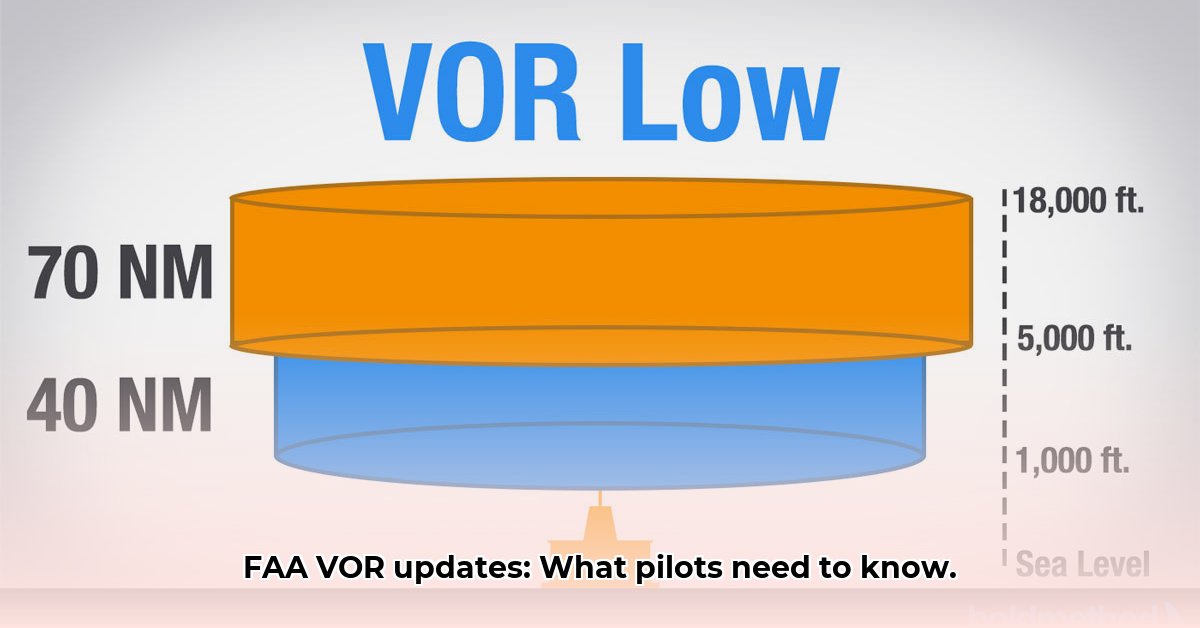
Navigating the skies just got a little simpler (and safer) thanks to recent FAA updates to the VOR system. These changes streamline VOR navigation, enhancing efficiency and reliability. While GPS remains the primary navigation tool, VORs serve as crucial backups, ensuring safe landings even with GPS failure. This guide explains the updates and how to adapt.
Understanding the Changes: Streamlined VOR Navigation
The FAA's updated VOR system improves efficiency and airspace coverage. Fewer VORs are needed, yet the remaining ones cover more ground. This update isn't just about reducing infrastructure; it's about enhancing the reliability of the backup navigation system.
The New VOR Service Volume Classification: Five Categories for Clarity
Previously, VOR service volumes had three categories. Now, there are five clearly defined categories:
- Terminal (T): Low-altitude coverage near airports.
- Low (L): Lower-altitude coverage, typically used below 18,000 feet AGL (Above Ground Level).
- High (H): High-altitude coverage.
- VOR Low (VL): Combines the functions of the previous T and L designation.
- VOR High (VH): Combines the functions of the previous H designation. Often has layered coverage.
These codes, prominently displayed on navigational charts, indicate the VOR signal's reach at different altitudes. Understanding these codes ensures safe and efficient flight.
Charting a Course with the Updated Charts: Accurate Information
The FAA integrated these new VOR service volume (SSV) codes directly onto IFR enroute charts starting in 2022. This improves information accessibility. However, always cross-reference with the latest chart supplements to guarantee accuracy. Safety remains the highest priority.
Are you fully utilizing the improved chart integration? Understanding the new codes can significantly improve your navigation efficiency and safety.
Impact on Pilots and Flight Schools: Adapting to the New System
Pilots must familiarize themselves with the new procedures: recognizing the new codes, interpreting updated charts, and understanding how the changes impact flight plans. Flight schools must integrate these updates into training programs immediately, using simulators and practical flight exercises. This prepares pilots for various scenarios, including GPS outages.
What steps are you taking to ensure your flight training incorporates these critical updates? Up-to-date training is crucial for safe air travel.
Adapting to the New VOR Service Volumes: A Step-by-Step Approach
Here's a practical guide to help you adjust:
- Review FAA Documentation: Familiarize yourself with the official FAA guidelines.
- Master the New Charts: Practice identifying the new SSV codes (T, L, H, VL, VH) and their meanings.
- Update Navigation Systems: Ensure your EFB (Electronic Flight Bag) and other navigation tools are updated. Outdated software can lead to inaccuracies and dangerous situations.
- Practice Flight Planning: Plan several flights, integrating the updated VOR coverage areas.
- Develop Backup Plans: Create alternative navigation procedures in case of VOR or GPS failure. Having a plan B is crucial for safer flying.
Key Changes at a Glance: A Comparison of Old and New Systems
This table shows a direct comparison:
| Feature | Old System | New System |
|---|---|---|
| Number of SSVs | Three | Five (T, L, H, VL, VH) |
| Chart Integration | Separate publications | Integrated into enroute charts (2022 onwards) |
| Altitude Coverage | Limited at higher altitudes | Significantly expanded at higher altitudes |
| Code Designation | Less standardized | Standardized codes (T, L, H, VL, VH) |
How to Interpret New VOR Service Volumes on 2022 Enroute Charts
The 2022 enroute charts clearly depict the new VOR service volumes. Understanding their visual representation is crucial for accurate navigation.
"The updated charts provide a much more intuitive visual representation of VOR coverage," says Captain Amelia Hernandez, Chief Flight Instructor at the National Flight Academy. "This makes flight planning significantly faster and easier."
Understanding the Changes: Simplified Classifications
Before 2022, VOR service volumes were categorized as T, L, and H. Now, it's VL and VH. This simplification is directly reflected on your 2022 enroute charts.
The following points summarizes the key changes:
- Fewer VORs but wider coverage areas per VOR.
- Simplified SSV classification.
- Clear depiction on 2022 IFR enroute charts.
- Critical for GPS backup navigation.
Practical Steps for Pilots: A Smooth Transition
Follow these steps for a seamless integration of the new system into your flight procedures:
- Familiarize yourself with the new terminology. The new codes are VL and VH.
- Study the updated charts. Practice identifying the new service volumes.
- Review your flight planning procedures. Include new service volume data in your flight plans.
- Stay updated. Be vigilant with FAA updates on VOR decommissioning.
The Importance of Redundancy: A Backup Navigation System
While GPS is the primary navigation system, VORs remain critical backups, especially in GPS outage situations. Understanding the updated charts enhances your ability to safely navigate even under critical conditions. The FAA's changes underscore this need for reliable backup systems.